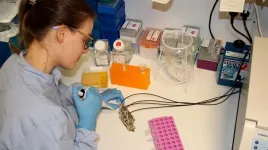Using acalabrutinib as initial treatment for chronic lymphocytic leukemia Chronic lymphocytic leukemia (CLL) is a cancer that occurs in the blood, bone marrow, lymph nodes, liver and spleen. It is the most common leukemia in adults, and while there are treatments to control and manage the disease, it is difficult to cure. A clinical trial led by William Wierda, M.D., Ph.D., demonstrated that acalabrutinib, a drug that selectively inhibits Bruton's tyrosine kinase, can safely and effectively treat CLL. While the drug was previously used for relapsed CLL, this trial provides evidence for expanding its use for patients who have not yet received chemotherapy or another treatment. Of the 99 treated patients, 97% responded to the treatment and, after 53 months of follow-up, 85 patients remained on treatment. Thirty-eight percent of patients experienced side effects, such as infection, hypertension and atrial fibrillation. Since acalabrutinib showed durable efficacy and long-term safety in this trial, it can be considered an initial therapeutic option for symptomatic patients with CLL. Learn more in Blood.
DNA-cutting enzyme may be a novel cancer treatment target During DNA replication, a structure known as the replication fork is formed at the interface between new and old DNA. Stalls at the fork can lead to replication stress and genome instability, a hallmark of cancer. Research led by Chi-Lin Tsai, Ph.D., and John Tainer, Ph.D., at MD Anderson find that exonuclease V (EXO5), a DNA-cutting enzyme, plays a critical role in restarting stalled replication forks. The researchers resolved the protein structures for EXO5 alone and bound to DNA, leading to a new understanding of its interaction with DNA and other protein partners, critical for structural-based drug discovery. Their work suggests that EXO5, which is mostly elevated in tumors that correlate with poor patient survival, may be targeted as a novel treatment strategy. Learn more in Molecular Cell.
Cancer cells reprogram the Golgi apparatus to increase pro-tumor protein secretion Increased secretion of pro-tumor signaling proteins by cancer cells can reorganize the surrounding microenvironment to promote tumor growth, enable metastasis and drive therapeutic resistance. Two new studies from the lab of Jonathan Kurie, M.D., reveal how genetic alterations in cancer lead to hypersecretion by the Golgi apparatus and point to possible therapeutic strategies to block these pathways. Work led by Xiaochao Tan, Ph.D., published in Science Advances, found that loss of TP53 reprograms Golgi proteins to create a positive feedback loop that promotes secretion of pro-metastatic proteins. Blocking these Golgi proteins impaired growth and metastasis of p53-deficient cancers and inhibited immune suppression in the tumor microenvironment. A study led by Lei Shi, Ph.D., published in Proceedings of the National Academy of Sciences, found that lung cancers with a certain chromosomal alteration become addicted to synthesis of the PI4P lipid - part of the Golgi membrane - for increased secretion and cancer cell survival. This reliance on production of a specific lipid could be a vulnerability to target in genetically-defined lung cancers.
Protein plays previously unknown role in resistance to radiation therapy Radiation therapy is one of the pillars of cancer care, used to generate DNA damage and eventual cell death in cancer cells. Normal cells can overcome much of this damage with normal repair processes while cancer cells typically cannot. However, some cancers exhibit resistance - making radiation therapy less effective. Research led by Qinglei Hang, Ph.D., and Li Ma, Ph.D., discovered a role for the protein DGCR8 in promoting resistance to radiation therapy, although it is normally involved in generating small RNA molecules called microRNAs. After ionizing radiation, DGCR8 is modified and stabilized, leading other proteins to form a complex and to repair the resulting DNA damage in cancer cells. The results suggest that targeting DGCR8 or its partners may be an approach to sensitize tumors to radiation and to overcome therapy resistance. Learn more in Nature Communications.
Neoadjuvant immunotherapy in resectable head and neck cancer The standard of care for locoregionally advanced, resectable cutaneous squamous cell carcinoma of the head and neck (CSCC-HN) is surgery followed by radiation therapy. This aggressive treatment regimen can cause disfigurement and loss of functionality, and about 30% of patients experience disease recurrence. In a single-institution Phase II clinical trial, led by Neil Gross, M.D., 20 patients with resectable stage III-IVA CSCC-HN received two cycles of the PD-1 inhibitor cemiplimab before surgery. While cemiplimab is approved to treat unresectable CSCC-HN, this is the first study to report on neoadjuvant use for resectable CSCC-HN. Cemiplimab was safe and effective, with a pathologic response rate of 70%. As a result, many patients did not require radiation therapy and remain free of cancer nearly two years later. Response was associated with an inflamed tumor microenvironment, including enrichment of CD8+ T cells. Learn more in Clinical Cancer Research, a journal of the American Association for Cancer Research.
Discovering new treatment targets in KRAS-mutant pancreatic cancer Pancreatic cancer remains one of the leading causes of cancer death in the United States. More than 90% of cases are caused by mutations in KRAS, but there are no available targeted therapies to block the most common KRAS mutations in pancreatic cancer. A research team led by Liang Yan, Ph.D., Wantong Yao, M.D., Ph.D., and Haoqiang Ying, Ph.D., used a mutant KRAS model of pancreatic cancer to find new targets downstream of KRAS signaling. They confirmed the RAF/MAPK signaling pathway as a critical downstream component, yet blocking this pathway with MEK inhibitors alone was ineffective. Their model also revealed significant reprogramming of cellular metabolism downstream of mutant KRAS. Blocking glucose metabolism sensitized pancreatic cancer cells to MEK inhibitor treatment, showing strong anti-tumor effects and suggesting this combination approach warrants further investigation. Learn more in Cancer Research, a journal of the American Association for Cancer Research.
A community program tackling high cervical cancer rates in the Rio Grande Valley Significant cervical cancer disparities exist along the Texas-Mexico border in the Rio Grande Valley, where incidence and mortality rates are approximately 55% higher than in the U.S. overall. Cervical cancer is preventable with human papillomavirus (HPV) vaccination or through early diagnosis and treatment of precancerous cervical dysplasia. A team led by Kathleen Schmeler, M.D., implemented a comprehensive, community-based intervention to increase cervical cancer screening, diagnosis and treatment in the region. The program provided cervical cancer screening to 14,846 women over four years. A total of 2,030 women underwent colposcopy for abnormal results (179% increase over baseline) and 453 were treated for cervical dysplasia. Local providers were trained to perform the procedures and received free, bi-weekly continuing education via virtual telementoring using Project ECHO. Learn more in Perspectives in Public Health.
INFORMATION:
In case you missed it
Read below to catch up on recent MD Anderson press releases across the spectrum of cancer research.
* Engineered NK cells can eliminate glioblastoma stem cells
About MD Anderson
The University of Texas MD Anderson Cancer Center in Houston ranks as one of the world's most respected centers focused on cancer patient care, research, education and prevention. The institution's sole mission is to end cancer for patients and their families around the world. MD Anderson is one of only 51 comprehensive cancer centers designated by the National Cancer Institute (NCI). MD Anderson is ranked No.1 for cancer care in U.S. News & World Report's "Best Hospitals" survey. It has ranked as one of the nation's top two hospitals for cancer care since the survey began in 1990, and has ranked first 15 times in the last 18 years. MD Anderson receives a cancer center support grant from the NCI of the National Institutes of Health (P30 CA016672).
© 2021 The University of Texas MD Anderson Cancer Center



